This website has been archived from TrainWeb.org/girr to TrainWeb.US/girr.
This website has been archived from TrainWeb.org/girr to TrainWeb.US/girr.
During September 2002, I spent a week on Maui. We stayed at the Maui Kaanapali Villas (recommended, especially room 263 which is clearly the nicest hotel room I've EVER been in). My hotel just happened to be across the street from a railway station at Puukolii road.
The Lahaina, Kaanapali & Pacific (aka The Sugar Cane Train) is a 3' narrow gauge tourist railway on the Hawaiian island of Maui. The equipment is all non-native, but the right of way is left over from a working sugar cane railway that shut down in 1953 when trucks took over the load. Eventually, the sugar mill itself was shut down and the remaing cane crop continued to be trucked to the last remaining mill about 20 miles away.
The line extends 5 miles from downtown Lahaina Towne north to the northern edge of the Kaanapali resort area. Stations are all adjacent to state highway 30 at Lahaina, the center of the Kaanapali area and at Puukolii road.
 LK&P #3 began its existance as an H.K. Porter
Company 38" gauge 0-4-0 saddletanker. For use on the LK&P, it was
been converted to a tender engine sometime in the late 60's. In the
process, it got converted to a 36" gauge 2-4-2 as well but there were
problems with the trailing truck and it got converted again to a
2-4-0.
LK&P #3 began its existance as an H.K. Porter
Company 38" gauge 0-4-0 saddletanker. For use on the LK&P, it was
been converted to a tender engine sometime in the late 60's. In the
process, it got converted to a 36" gauge 2-4-2 as well but there were
problems with the trailing truck and it got converted again to a
2-4-0.
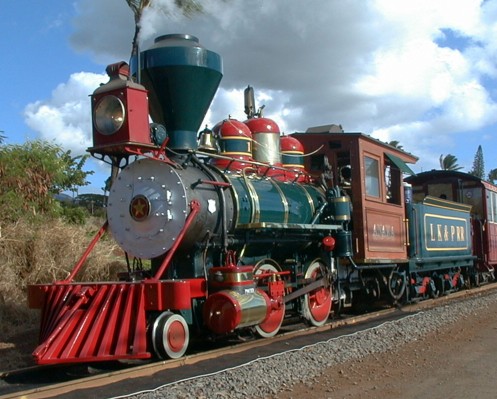 An identical engine was converted to LK&P #1. This
one has been cosmetically converted to look like a Baldwin prototype.
This prototype used to run on an Oahu cane railway. The Oahu engine was
in turn the prototype for the original Bachmann 2-4-2 large scale
model.
An identical engine was converted to LK&P #1. This
one has been cosmetically converted to look like a Baldwin prototype.
This prototype used to run on an Oahu cane railway. The Oahu engine was
in turn the prototype for the original Bachmann 2-4-2 large scale
model.
Both steamers burn reclaimed motor oil collected on Maui. The engines like it, its cheap, it burns fairly cleanly, and it gets rid of the used oil. Sounds like a deal to me.
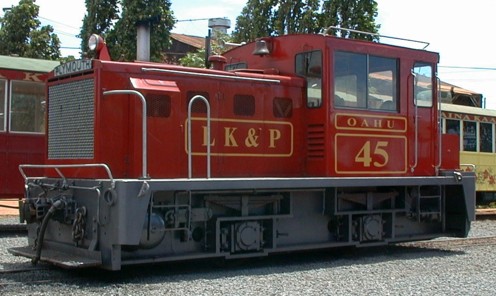 #45 is a Plymouth diesel mechanical locomotive that is
put into service occasionally. It did run while I was there. It has a
unique peanut whistle that sounds much different than the steamers.
#45 is a Plymouth diesel mechanical locomotive that is
put into service occasionally. It did run while I was there. It has a
unique peanut whistle that sounds much different than the steamers.
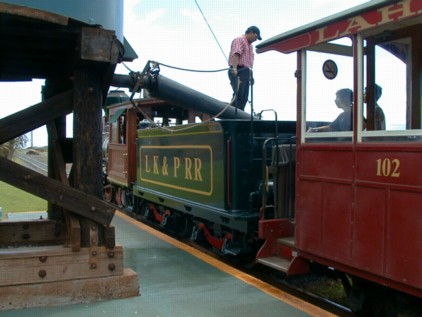 Once each round trip on
the southbound leg the steamers take on water at the Kaanapali station.
The water is processed by a reverse osmosis system in a building next
to the tank.
Once each round trip on
the southbound leg the steamers take on water at the Kaanapali station.
The water is processed by a reverse osmosis system in a building next
to the tank.
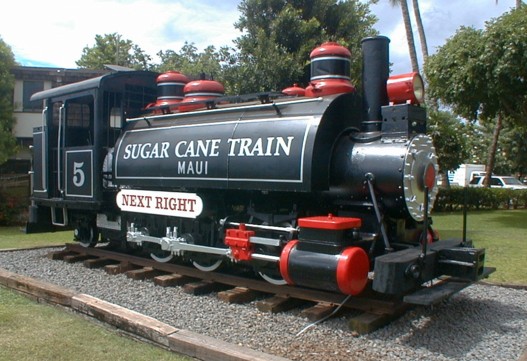 At the Lahaina station, an 0-6-2 outside frame
saddletanker rests on static display. This is primarily an eye catcher
to attract potential riders that go by on highway 30 which runs right
through town and immediately by the station.
At the Lahaina station, an 0-6-2 outside frame
saddletanker rests on static display. This is primarily an eye catcher
to attract potential riders that go by on highway 30 which runs right
through town and immediately by the station.
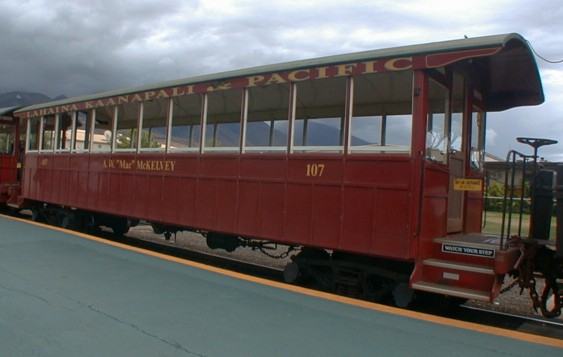 The coaches of the LK&P are custom made to
resemble an English design. These cars, however, are made frome steel
instead of wood and all the windows work. On the originals, only the
windows in first class could be closed to keep out the rain. Each coach
seats 56 passengers on flip over seats. On the return leg of my trip,
the train was completely full. The railway has carried over 6 million
passengers at about $15 for a round trip since it opened in about 1963.
This makes it one of the most heavily used tourist railroad in the
US.
The coaches of the LK&P are custom made to
resemble an English design. These cars, however, are made frome steel
instead of wood and all the windows work. On the originals, only the
windows in first class could be closed to keep out the rain. Each coach
seats 56 passengers on flip over seats. On the return leg of my trip,
the train was completely full. The railway has carried over 6 million
passengers at about $15 for a round trip since it opened in about 1963.
This makes it one of the most heavily used tourist railroad in the
US.
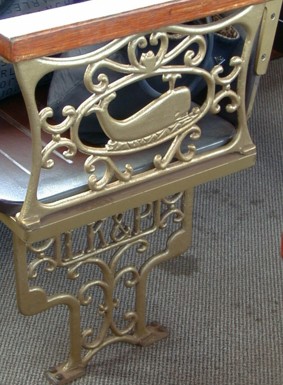 Since these cars were custom made, even the chair
castings are custom. The train ride is narrated. Once a week on
Thursdays, the railroad runs a dinner train for about $60. Dinner is
not served on the train, but at the Kaanapali station.
Since these cars were custom made, even the chair
castings are custom. The train ride is narrated. Once a week on
Thursdays, the railroad runs a dinner train for about $60. Dinner is
not served on the train, but at the Kaanapali station.
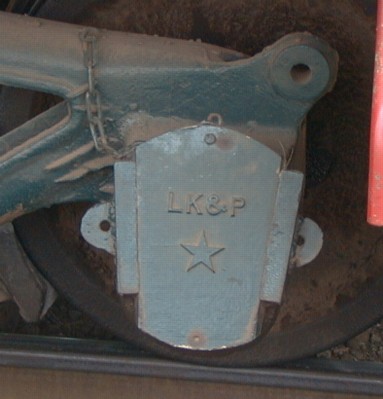 On some of the cars, even the journal box covers
were especially cast for the railroad.
On some of the cars, even the journal box covers
were especially cast for the railroad.
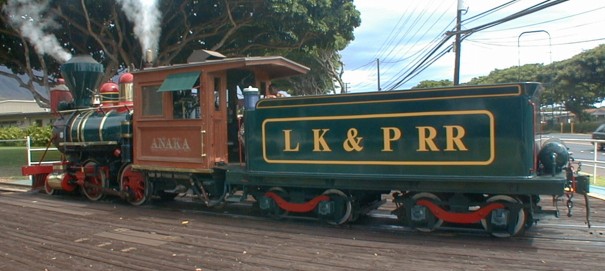 At the south end of the
line at Lahaina Station, the engines are turned on this powered
turntable. The engine then runs around the train and hooks up at the
north end. At the north end of the line just beyond the Puukolii
Station, there is a loop that encircles the engine house to allow the
whole train to be turned.
At the south end of the
line at Lahaina Station, the engines are turned on this powered
turntable. The engine then runs around the train and hooks up at the
north end. At the north end of the line just beyond the Puukolii
Station, there is a loop that encircles the engine house to allow the
whole train to be turned.
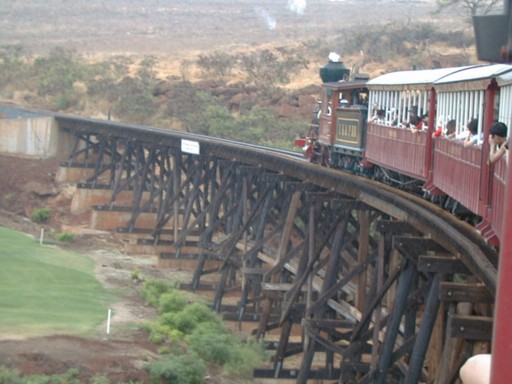 Near the highest
point on the line (about 80' above sea level) there is a 350' long
trestle. This photo is a little blurred due to the rather heavy rain
that was falling at the time. This was the northbound leg. On the
southbound leg, the engineer opens up the blow cocks and blows out
collected sludge.
Near the highest
point on the line (about 80' above sea level) there is a 350' long
trestle. This photo is a little blurred due to the rather heavy rain
that was falling at the time. This was the northbound leg. On the
southbound leg, the engineer opens up the blow cocks and blows out
collected sludge.
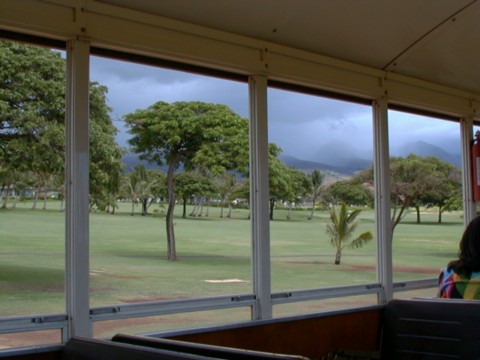 The railroad runs through this wilderness area. Natives
and visitors can be seen chasing little white balls around this
tournment class 18 hole golf course.
The railroad runs through this wilderness area. Natives
and visitors can be seen chasing little white balls around this
tournment class 18 hole golf course.
The terrian in the background slopes up to the Halemahina Volcano (5788'). The top of this volcano gets something line 400" of rain a year although this side gets relatively little rain. The larger Haleakala (10,023') volcano makes up the southern part of Maui. It is so tall, that the top gets almost no rain. On the Hana cost on the southwest and south sides, there is a rain forest.
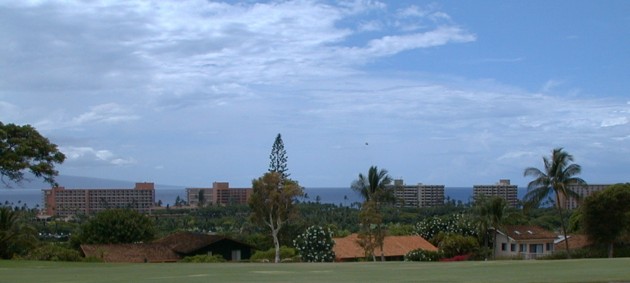 On the other side of of the the track lies the quaint
village of Kaanapali complete with a slightly non-native form of
visitor housing. The Kaanapali coast is a master planned resort region
just stuffed with high class (expensive) hotels.
On the other side of of the the track lies the quaint
village of Kaanapali complete with a slightly non-native form of
visitor housing. The Kaanapali coast is a master planned resort region
just stuffed with high class (expensive) hotels.
© 2002 George Schreyer
Created 3 Sept 2002
Last Updated September 3, 2002